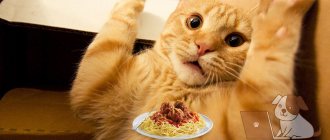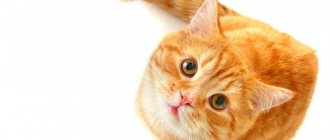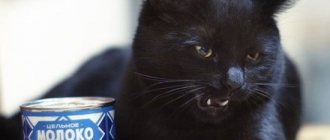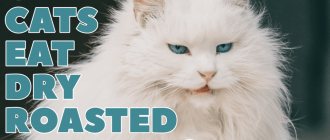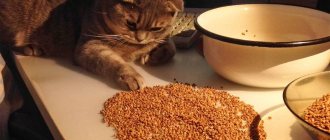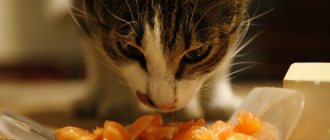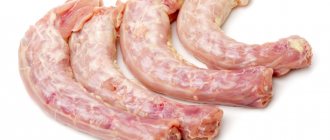Is it possible to give a cat bread?
Bakery products can be given to an animal, but in small quantities and provided that it likes such food.
The product is a source of essential vitamins, carbohydrates and minerals, but if given in excessive quantities, it causes digestive problems. Along with complex carbohydrates, when consuming such baked goods, the cat receives B vitamins, magnesium, potassium, and iodine. Yeast, which is an essential component of baked goods, increases appetite, which can be used when trying to feed a sick animal.
What Bread Shouldn't Contain
A product that is safe for cats does not contain dyes or preservatives of synthetic origin.
If you want to pamper your pet with homemade baked goods, you should not add baking powder to the dough. Veterinarians insist that introducing yeast bread into an animal's food can cause constipation or fermentation processes in the intestines. You should not give your cat products with garlic, onions or nuts. It is recommended to protect the animal from baked goods with the addition of chocolate, bran, raisins, dried apricots or prunes.
The cat is not given bread with garlic.
How much is safe to give?
Considering the high calorie content of the product, its share in the daily diet should not account for more than 10%. Pampering your pet with a large piece of bread is only allowed if it does not receive such food regularly.
About the benefits of bread
According to historians and archaeologists, the first bread was a grain mush, and people learned to make it back in the Neolithic era. Having learned to make fire, man began to bake unleavened cakes from cereal grains. And in Ancient Egypt they figured out how to bake fluffy rolls - by loosening the dough using fermentation. Later, the technology was adopted by the Greeks and Romans, followed by residents of other countries.
Why is bread so useful? The basis of any baking is flour - it is obtained by grinding grains of wheat, rye, barley, and corn. Cereals contain useful substances that are preserved even after heat treatment:
- vegetable proteins;
- cellulose;
- fats;
- carbohydrates;
- microelements - calcium and sodium, iodine, copper, potassium and phosphorus, magnesium and others.
There is no point in talking about the nutritional properties of bread - a person can live for a long time “on bread and water.” The average calorie content is 250 kcal/100 g - this is higher than that of meat products and chicken eggs. Considering that a cat’s daily nutritional requirement is only 250 kcal, then you wouldn’t feed your pet just bread?
What is useful in bread for animals:
- a large amount of carbohydrates - a universal source of energy. After grain processing and heat treatment, they retain their properties;
- high percentage of fiber. Most of it is found in whole grain bread and bread that contains bran. Fiber keeps the body in good shape and protects it from excess cholesterol and toxins;
- presence of microelements. Phosphorus is necessary for healthy bones, potassium supports the functioning of the nervous system, normalizes blood pressure, magnesium contributes to the proper functioning of the circulatory system, calcium is the basis of strong bones and teeth. Iron and potassium help strengthen the immune system, remove toxins from the body and help digest proteins;
- vitamin content. There are significantly fewer of them in bread than in vegetables, fruits and whole grains. However, baked goods contain B vitamins, which are responsible for metabolic processes in the body, and vitamin H, which maintains the health of the cat’s skin and coat.
A positive quality of baked goods is their hypoallergenicity. Rare cases of allergies are associated with additives - spices and spices, sugar, yeast. But it is precisely because of the additives that bread is contraindicated for pets.
The dangers of eating too much bread for cats
Without limiting the pet's consumption of yeast-based baked goods, the owner risks causing the pet to develop obesity.
Love for the product can cause other cat health problems:
- urolithiasis and joint pathologies due to the consumption of salt, which is part of bread;
- increased gas formation, which occurs as a result of an insufficient amount of enzymes capable of breaking down the incoming flour;
- vomiting and nausea due to intolerance to the additives included in the product;
- respiratory failure, convulsions, intestinal obstruction due to the adhesion of poorly baked dough to the walls of the esophagus or intestines.
Love of bread can cause urolithiasis.
Many pet owners believe that there is nothing wrong with their pet’s weakness for such baked goods, so they do not limit the amount of product they consume.
However, using baked goods as the basis of a domestic cat's diet leads to:
- deterioration of the condition of his coat;
- bone fragility;
- tooth loss;
- obesity;
- lethargy and drowsiness;
- kidney problems;
- development of pathologies of the cardiovascular system;
- diarrhea and constipation.
Why can't cats eat a lot of bread?
Carbohydrates, fats and a small amount of protein are found in almost many flour products, such as pasta, and some cats like to eat it with cheese. Many cats love to eat high-fat cookies and muffins as an efficient source of energy, but you should not overfeed your cat bread and other baked goods, as this can be harmful and lead to obesity! So it’s still better not to give bread to your cat in large quantities.
See also: what cereals can a cat eat?
What kind of bread can you give a cat?
When choosing a treat for an animal, you should give preference only to natural products prepared without adding spices, raising agents or preservatives. Even if a cat happily eats overcooked bread, it should be excluded from its diet so as not to increase the risk of developing malignant tumors.
Variety
Under normal conditions, cats that have the opportunity to get their own food prefer rye bread. It contains fewer harmful elements, and the amount of magnesium, potassium and iron is higher. Black bread is easier to digest and less likely to cause digestive disorders.
Cats prefer rye bread.
Freshness
It is strictly forbidden to give fresh, warm product to animals due to the yeast it contains. The pet's menu is allowed to include a product baked at least 24 hours ago. When choosing between dried bread and crackers cooked in the oven, preference is given to the former.
Is it worth feeding?
Wheat bread is a neutral product. The classic loaf contains no substances that are toxic or dangerous to animal health, but there is also little benefit from it: the proportion of dietary fiber, microelements and vitamins in processed flour is practically negligible, and the calorie content of white bread is high. Although whole grain varieties contain many useful substances, it is not necessary to intentionally give bread to your cat.
Not all pets gravitate towards flour and eat it with pleasure. But if a cat really loves baking, the owner should be careful. The enzymes in the animal’s stomach and intestines are unable to process large amounts of carbohydrates that make up bread, so you should not encourage your pet’s hobby, especially a young one, so that eating flour does not become a habit.
A cat's love for bread can be put to good use, for example, by feeding her medicines hidden in the crumb of bread, which she eats with pleasure.
Experts advise teaching your pet a healthy diet from an early age.
Veterinarians remind that a kitten’s behavior, including eating behavior, is formed from the first months of life, so proper nutrition and high-quality food are especially important for him at this time. It is recommended to feed the kitten healthy and harmless food, without being carried away by useless treats. A three-month-old baby has already formed gastronomic habits: at this time the kitten switches to the diet of an adult animal. If you set the right vector in childhood, from the first months of life, then in the future this will protect the young cat from troubles with the digestive system, and, in addition, will help avoid greed for harmful foods.
Harm and consequences
Any flour products are not recommended for cats with a weak digestive system. Eating even a small amount can cause vomiting, bowel dysfunction, and flatulence, so it is best to exclude bread from your pet’s diet. Burnt or overcooked bread contains a dangerous substance - acrylamide, it is equally harmful to humans and animals, such a product is highly not recommended for consumption.
It must be remembered that baked goods, especially sweet pastries, contain complex carbohydrates. Their abuse invariably leads to obesity, arthritis and even diabetes. The basis of a carnivore's diet is protein, while bread cannot compensate for it. Overeating bread reduces taurine levels, and its deficiency causes the following consequences:
- deterioration in the quality of teeth;
- hair loss and loss of shine;
- cardiovascular diseases;
- pathologies of the reproductive system.
Can cats and kittens have bananas?
Is toast and croutons safe for cats?
Not only people love toasted bread, but also many cats. These products are not dangerous in small quantities, but they are not recommended to be given to your pet every day. If bread is burnt in a toaster, it is recommended to throw it away, since burnt toast contains acrylamide, a product very harmful to the health of people and animals. Toast or toast should not be very hard. If the animal has difficulty chewing them, it is recommended to soak the bread in milk.
Veterinarians do not recommend feeding cats toast or sandwiches containing the following ingredients:
- Chocolate butter. Chocolate and other sweet foods are contraindicated for cats.
- Butter. It is not advisable to give sandwiches with butter to your pet, since such food contains a lot of calories and fat.
- Peanut butter. It is better not to give bread and toast with peanut butter to cats; this product contains a lot of fat and salt.
- Avocados are a safe and healthy food for humans, however, they contain persin, which causes heart and lung disease in cats. Therefore, it is better not to treat your pet to croutons with avacado paste.
- Seasonings. Mayonnaise, ketchut, mustard and other condiments are very harmful to cats. For this reason, you should not treat your pet to hot dogs and similar foods.
How to give bread correctly so as not to harm your pet?
Bread products should not make up the vast majority of your cat's daily food intake. It is better to give bread in strictly limited quantities and, if possible, not every day. You cannot feed your pet:
- Bread with additives or spices.
- Sandwiches with creamy peanut or other butter.
- Bread with sauce: cheese, mushroom, mayonnaise, ketchup and others.
- Sweet pastries, especially with chocolate.
Very often, owners pamper their pets with bread with sour cream or soaked in milk. This is not prohibited, but do not forget about the rule - everything is good in moderation. It is also not forbidden to give croutons or bread toasted in a toaster, but do this no more than twice a week.
To summarize, we can safely say that bread is not contraindicated for cats if you follow all the above recommendations, not forgetting about the norm, but there is no need to deliberately accustom the animal to this product.
can cats be given ice cream?
Proper feeding
Bread acts as a delicacy for animals. It is indispensable in a cat’s diet, as it contains minerals and vitamins. In order not to cause harm, it is allowed to consume flour products without preservatives, leavening agents and other harmful components. Homemade rye varieties of bread are best suited for feeding.
Before giving the product to an animal, it must be crushed. It is not recommended to feed your cat bread more than once a week. The diet should include food containing protein and a bowl of water. Water or milk helps push through flour products.
Can I give my pet bread dough?
It is extremely undesirable for cats to consume raw dough; it can lead to bloating and stomach problems of varying severity.
If a large amount of dough is eaten, convulsions, poisoning, and sometimes respiratory failure may occur. In addition, an increase in the volume of product in the intestines can cause acute obstruction. In such cases, you should immediately contact your veterinarian. To avoid all of these consequences, it is necessary to keep the dough out of reach of the animal. Yeast-free dough with the addition of soda is no less dangerous for cats. In case of overeating, it can cause heart failure, muscle spasms, and a sharp decrease in potassium in the body.
